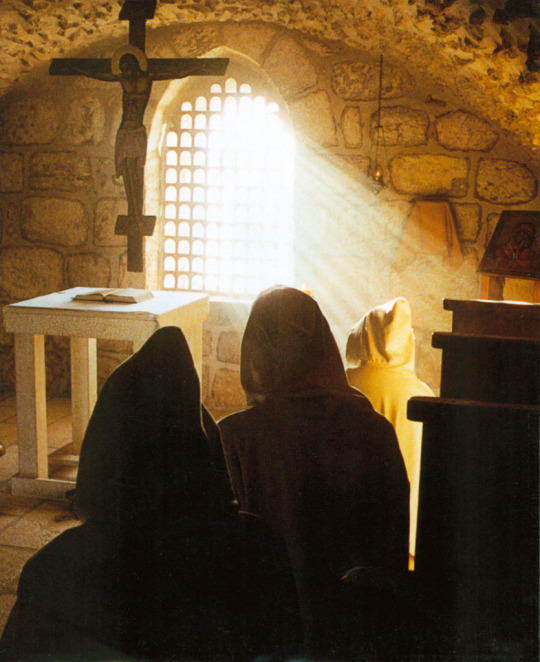#Monastic Life
Text
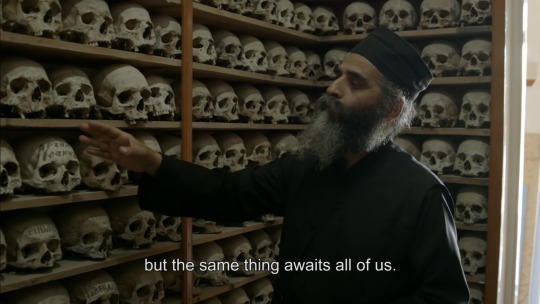
#orthodox christianity#eastern orthodox#eastern orthodoxy#orthodox#orthodoxy#christianity#greek orthodox#monasticism#monastic life#mount athos#holy mountain
2K notes
·
View notes
Text
I'm not even remotely religious in any way, but I am begging people who are going to write about a character going into a monastery/nunnery whatever to please, please, please read some of the Cadfael Chronicles before you cast an entire population of people as fire-and-brimstone, self-mutilating, repressed, fanatical zealots.
For the uninitiated, the Cadfael Chronicles was a long series of medieval-set (specifically set in the 12th century) murder mysteries where the gumshoe role is taken by a monk who is well into middle age, a skilled herbalist and a former soldier and sailor who joined the Order late in his life (which for one, did happen!).
Now, there are some dated things about the writing that bears some examining; Ellis Peters (psued for Edith Pargeter) first started writing then in the late seventies (the last book was published 1994, a year before her death), and while she was a fantastic amateur self-taught scholar (she was so good she got an honorary degree from Birmingham University, having never even been to any higher education than high school) she is writing about the time of the Crusades and the Crusaders who invaded Jerusalem and she doesn't really delve that deep into the implications of her characters being involved in that, even though the characters are portrayed as the good guys, especially the titular one. But it's very possible most of the scholarship she had available for research at the time was all Western perspectives, which, you know, history is written by the winners, etc. She has a writers bias towards her protagonist, so of course he is framed fairly glowingly, though not without flaw.
But whether she had a view on the moral implications of the Crusades or not, the way she wrote medieval Britain and medieval Wales is absolutely textually fascinating because she doesn't flinch away from the fact that yes, Britain at this time was a feudal serfdom with slaves included, and was hard on marginalized people, chock full of patriarchy that did affect the lives of her female characters or that the Church was a big landowner themselves, and there was plenty of political tension and violence due to an ongoing civil war, but nonetheless the town the Chronicles are set in and the monastery where Cadfael lives is portrayed as a community.
Seriously. They don't just pray and whip themselves for 'bad thoughts'. The monks can be funny, snarky, and shy, and ambitious. They can be irreverent - yes, even about God, that thing that they are meant to be the most reverent about. They can have petty rivalries, they can annoy one another, even the Abbot, and not be sent for a backbreaking penance. They aren't thumping on bibles and telling people that if they don't make the cut that they're going to burn in hell.
They care. They take care of the children left in their charge, whether they're rich scions there to get an education or some poor thing left on their doorstep. One monk, in charge of the children, expresses real and genuine concern over a new novice that is having horrific dreams, worried that he has suffered a tremendous hidden trauma (he's right) and they're all concerned about what they can do to help him. A pair of teenagers literally fuck on one of the altars and the reaction from Cadfael is rueful amusement at young people's folly, not disgust or anger. They collect alms for the poor, redistribute everything given to them to help people survive. They crack jokes and show each other kindness and...
... look, I'm not saying that there weren't and still aren't zealots in religion. No religion is really innocent of that. And yeah, those zealots have done some pretty heinous things when they're put in charge - see Witch Burnings, Various Inquisitions, Crusades, Terrorism, etc. But I do wish writers wouldn't write about religious life like everyone who ever entered it was either a complete bag of bible-thumping assholes or just miserable all the time.
For one thing, that's really boring. Religion is a way we can tell stories about the complex reality we live in and the rules we think are important when dealing with other people. To reduce all that potential down to Miserable, Repressed, Self-Harming, Witch Hunting Jerks is intellectually lazy at best.
For another thing, you are losing the opportunity to portray a fundamentally queer experience. I don't mean they were all fucking (although some of the proscriptions that they felt the need to write down would rise your eyebrows - hand holding was apparently banned at one point); I meant that this was a group of people that took themselves out of the amatonormative status quo entirely and dedicated themselves to something that wasn't marriage, children, mercantile endeavors or anything 'normal' like that. That was, at the very least, a queer experience with clear queerplatonic overtones (not to mention, there were FTM trans monks that literally went on to sainthood, chosen gender kept intact).
And also? It just isn't historically accurate. Plenty of men and women actively chose a life outside the norm because they wanted to serve god and the community. They're just a group of people, all living together, making space for one another, all trying to serve people in whatever way they can. These people were less raging witch-burners and more Jedi without the lightsaber.
In the Cadfael books, they have brushes with zealots and they're reviled as bad guys every time. One (in the very first book) more or less fakes a whole-ass vision to manipulate the order to go to Wales and try and acquire a Welsh saint's bones and ends up doing even worse things because he believes he is destined for greatness and will get it by whatever means necessary. The head of the mission (who edges close to zealot territory himself and fully buys into the con for his own benefit) tries to buy the saints relics and causes a massive diplomatic incident as a result of this insult that makes him look like an idiot.
The other zealot that gives them trouble is a priest appointed to run the church. This man is as big a bible thumping, hellfire and brimstone dickhead as you might always picture a medieval priest to be and he is uniformly despised by both the monks and the township at large because his zealotry and strict adherence to only the letter of religious law and nothing else actively harms the community.
He's so hated, in fact, that when he (spoilers) dies, the reactions of all and sundry is mostly just relief that he's gone.
The Catholic Church has a lot of sins that it forgets more than it reckons with, but that doesn't mean that life in a monastery was all hair shirts and self-mortification, every abbot a little dictator. People have lived just fine in small communes for a lot of human history and they didn't all have small-minded tyrants continually cracking the whip. Most of them didn't.
I know it's an easy shaft to mine angst from, shoving people into an oppressive environment that they must either endure or overcome. And yes, the way we write about religion is sometimes a product of working through a complicated and traumatic relationship with it. I'm not trying to say any writer can't or shouldn't write that because your art is always supposed to be about putting parts of yourself out there, about telling the world a story about how you see it; and if you're working through something, if you need to tell a story about the scars that zealotry absolutely have and do leave, go for it, more power to you. That's a story that should and must be told.
But if your character is going into a monastery, try to remember that humans are social creatures. We make friends more than we make enemies. Even under intense tyranny, we make allegiances and form bonds and find ways to make the world were in a little bit more bearable wherever we can. And we tend to show each other compassion and mercy, even when we don't always like each other. It's true today, and it was true then too.
Monastic life was a queer experience that happened right under the noses of the dominant power structures for centuries. I think there's a story or two to be mined from that as well.
#writing#worldbuilding#character building#medieval history#religion#nicolo di genova#the old guard#brother cadfael#ellis peters#queerness#m#monasticism#monastic life
20 notes
·
View notes
Text
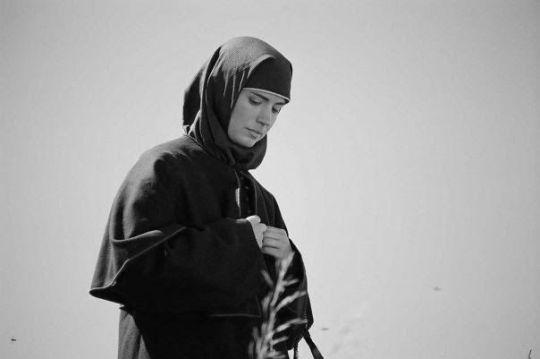
52 notes
·
View notes
Text

#orthodoxy#orthodox christianity#orthodox#christianity#eastern orthodoxy#eastern orthodox#orthodox christian#orthodox church#church#monks#monastic life#monastery
25 notes
·
View notes
Text
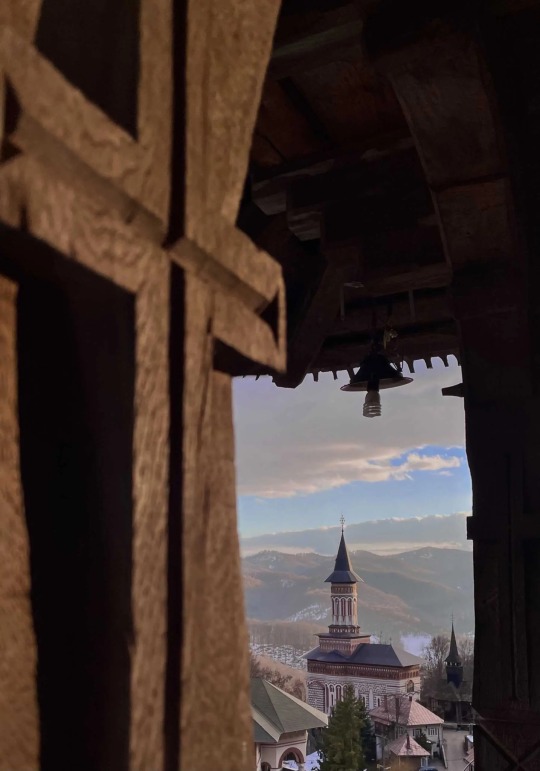
Rohia Monastery, where Nicolae Steinhardt lived after he was released from the communist prisons and took the monastic vows.
Photo: Sonia Potra
#romania#churches of romania#orthodox monastery#rohia monastery#monastic life#orthodox church#rural romania#architecture#sacral architecture#monk#nicolae steinhardt#photography#beautiful photos#landscapes#scenery#maramures#cross
61 notes
·
View notes
Text
How the celebration of Christmas began in the Western world
#Christmas#Anglo-Saxon England#English history#mediaeval#Middle Ages#Christianity#monastic life#Christendom#UK
13 notes
·
View notes
Text
Please pray for the receptivity of my family to my religious vocation, and the conversion of their hearts. I want them to be even more in love with God than I am, but I despair a bit that it could ever happen.
33 notes
·
View notes
Text
Book Review of 'Polytheistic Monasticism: Voices from Pagan Cloisters'

I wasn't entirely sure what I was expecting when I picked up this book but... generally I was expecting... more.
I don't feel like I learned much from reading this book, aside from prehaps that (unsurprisingly) those being called to deeper devotional practices in the Pagan/Polytheistic world are mostly being offered options based firmly in Western traditions. While I was sure that inspiration for such a movement would draw from monastic Christian traditions I had hoped to see it also drawing from antiquities temple traditions and, more modern, Eastern traditions where temples for worship are often maintained by monks/nuns and in this way monistaries and temples are one in the same.
Aside from getting a feel for the current climate and areas of inspiration that seem to be present inside this community... I don't feel like I learned... much of anything... most of the essays felt... a bit like advertisements to me... and most didn't feel particularly helpful to one interested in the path or particularly insightful in anyway.
To be honest this felt like a book that was created mearly to mark the phenomenon and offer a screenshot of it for the purposes of third-party study as opposed to a tool for someone genuinely seeking information about what this kind of calling might look like in their own lives.
#book review#books#pagan#polytheism#eclectic#Monasticism#monastic life#monastic#Polytheistic Monasticism#Jann Munin#blackcrowing
7 notes
·
View notes
Text
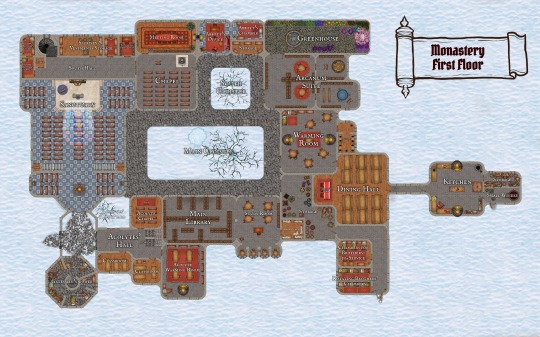
After much research on the Plan of St. Gall and Benedictine monastic life, I have completed the first floor of the monastery as it would've looked during its height of operations, roughly 200 years, give or take, before Lida et al. find it on their travels. I will be making another floor plan showing it in ruins.
Something to note is that this is where they encounter the terror-feeder, because the Northern Reaches really was the gods' DeviantArt page. Though I modeled this on Christian monastic life, the experiences of these monks are fundamentally different and far less ascetic so I made some fundamental changes.
Let me take you through some of the design choices I made!
Directional focus is the Overlook of the Gods, so southwest. The cathedral points in that direction as do both chapels.
Original Benedictine monasteries had very limited access points to the inner sanctum. I modified this with a few extras, but I still maintained some separation between the acolytes and monks.
Which leads me to the big main storage room. This was actually a surprising distance from the kitchens in the Plan of St. Gall.
The original kitchen had no outside access, iirc, but was separated from the main building by a hallway. I maintained this here, as it was a pragmatic and not religious decision; kitchen fires wiped out a hell of a lot of monasteries and abbeys before they moved the building off. Now they still maintained zero outside kitchen access, condemning anyone trapped in the kitchen to death, but I digress.
Monasteries were fully self-sufficient. This bad boy would’ve had crops and livestock and breweries. I did not want to design all that out because it would be gone by the time Lisa et al. arrive, but I did keep chambers for the brothers-in-service.
This place would have had an old men’s rest home to account for. Remember, part of the reason this monastery is so popular and well-maintained is because there’s too many men born in the Northern Reaches. (Don’t ask me why, I’m working on it.) So they would’ve had services for old impoverished men who couldn’t marry and had no families. I’m giving them three men assigned to the role and then an additional six that are cycled through the ranks to fulfill the mitzvah (for lack of a better word) of caring for others.
I eliminated the Benedictine conversation rooms, as Lida monks are free to talk, but kept the warming room out of practicality. It would be prohibitively costly to maintain fires everywhere. In monasteries that had dormitories, monks typically slept over the warming room, which will happen here. But unlike the ascetic Benedictines, I’ve given the brothers-in-service and others sleeping in beds far from the warming room little furnaces.
The conservatory is also not a traditional Benedictine room. My boyfriend asked the question of whether the era (roughly modeled on the Middle Ages) would’ve had such tech, which is absolutely valid, but the gods gave them a lot of knowledge. Also, greenhouses in general date back to 30 AD, when the Romans did it before it was cool.
Now we get to the big question: what the hell is up with the arcana rooms? Well, I may have jumped the shark. In constructing this on Inkarnate, I saw they had summoning circles, and I wondered, what if they had been practicing forbidden magic? Not magic outlawed by the Magisterium, but the one form of magic outlawed by the gods? What if they had accidentally summoned the terror-feeder from cryo underneath the Overlook of the Gods and this was their downfall?
I don’t have all the answers yet and I have a whole second floor to build before I can demolish it, but it’s interesting to think about and damn this was fun to make.
#Lida the defiant#fantasy writing#fantasy map#autistic writer#writing#writingblr#northern reaches#autism brain#monastery#monastic life#monasticism#Benedictine monks#Plan of St. Gall#floorplan
5 notes
·
View notes
Text
A reflective journal I wrote on the 19th of September, 2021.
'hope of salvation, & thoughts on ascetic life in prayer'
~ I acknowledge that I am a sinner and I have fallen to, and still am committing sin perpetually, same as before and after being illumined of the gravity of the sin and the urgency to have it ridden off.
After countless tries and while still at it, never have I felt more helpless whenever I find myself falling, then struggling to stand back up again to continue my spiritual battle; thinking that I am stuck in this loop of falling to temptations, over and over again, sinning.
Never have I felt so mortified that at the end of my life, finding myself before everyone in Judgment, that I'll be deemed unworthy and my soul be damned for eternity.
But I am certain that my hope stands still, for I am still given by God His grace of the gift of life that I enjoy daily to this day.
So I've come to terms with myself to always look forward to what I can, to do better on the things I did worse yesterday. To try to do, see, and be on the good and truth at all times, and to make sure it is for the greater glory of God.
Every Catholic Christian should aim to be a Saint. I myself could only wish to be, for I know I am no saint, for reasons of my struggle to sin at the beginning of this writing. Right now I don't see myself breaking through my habitual sin, and I've accepted it might be the cross I have to carry for my whole life, a "thorn that was given to me in the flesh, a messenger of Satan to harass me" -2 Cor 12:7.
Thus, realizing I won't be going out of this life like Saints do,I figured that my best hope for salvation would be in the purification of my soul in purgatory. With that said. I have the utmost respect and gratitude to people who spend their lives in contemplation and prayer, may they be from the Clergy or Laymen.
But especially the monks, as for me they are the ones who practice the most detachment, living in seclusion and isolation solely to give themselves to God, and even more so respectable to me that they do this as lay people.
With the ascetic and monastic life, I think monks are living as if already purging themselves in this life, but only with the privilege and indulgence of praying and being heard, and that their prayers reach out for everyone, both for the living on earth , and the dead in purgatory.
I don't see myself going into a vocation of religious life nor do I plan to, but if I am to choose to live a religious life, there would be nothing nobler than to lead a monastic life.
14 notes
·
View notes
Text

21 notes
·
View notes
Text
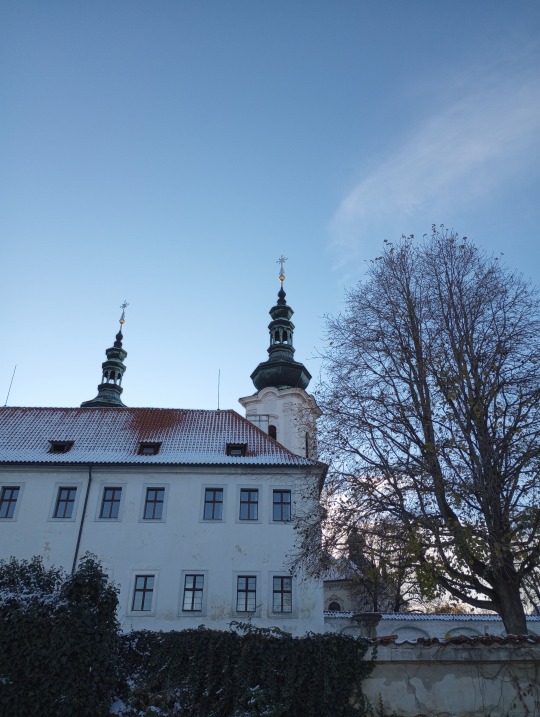

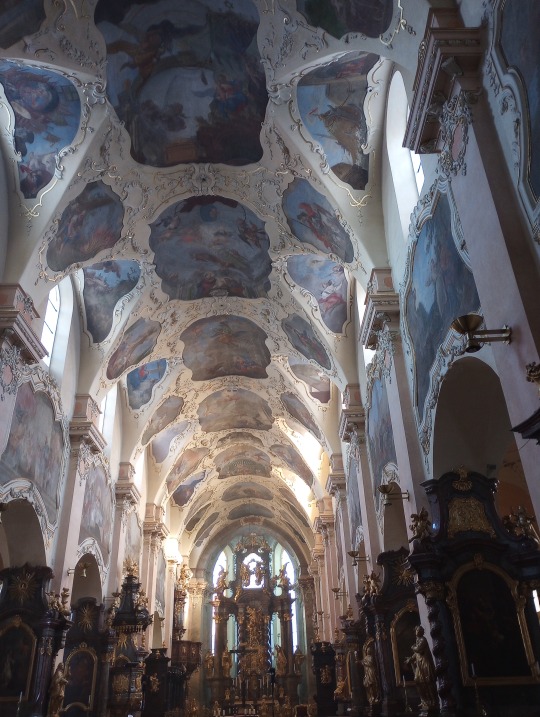
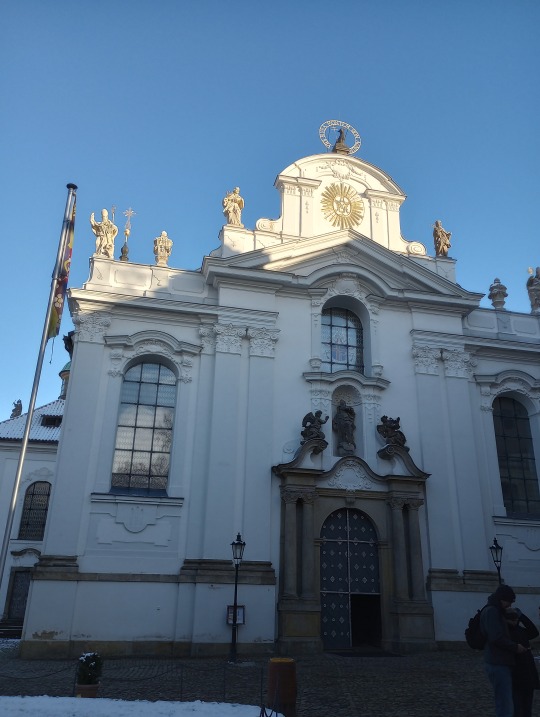
Old convent in Prague, does anyone ever think about becoming a nun?
3 notes
·
View notes
Text

This is the cell of Daniel the Hesychast in the Neamț County. Daniil was a famous ascetic, whom Prince Stephen III the Great (1457-1504) often consulted on matters of both personal salvation and politics.
Situated only one mile away from another historic landmark (Putna Monastery), this place of solitude and prayer was built by a single man, Daniil Sihastrul, that used nothing but a chisel in his quest of being as close to God as possible.
#romania#rural#scenery#landscapes#aesthetic#architecture#stone architecture#stone art#stone house#stone home#cell#asceticism#monastic life#monastery#orthodoxy#orthodox church#orthodox fathers#eastern europe#christianity#chisel
323 notes
·
View notes
